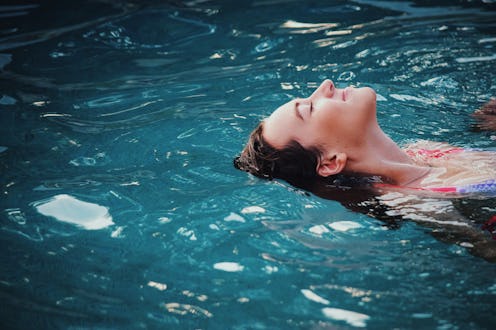
You've either experienced it yourself or seen it on somebody else, but green-tinged, post-pool hair is no fun for anyone. So why does chlorine make your hair green? Although you might've seen this unfortunate event unfold before your eyes, you may not be aware of the reason why it happens.
It doesn't matter whether you ended up with green streaks after giving yourself highlights in your youth, or you went a shade lighter in the salon before your summer vacay last year and your whole head of hair took on a yellow-green hue — the results of chlorine on freshly dyed hair can be disastrous. Of course, the more money you spend on your new 'do, the more devastated you're likely to be.
If you really want to hit the pool this summer with freshly lightened locks, you'd probably imagine that a hair cap would protect your mane, right? Well, it seems not even Olympic swimmers are safe from the effects of chlorine; in 2016, Ryan Lochte's hair turned blue-green, after he dyed it an icy blue color prior to partaking in the Rio Olympic Games. Thus, it appears that even swim caps don't fully protect against chorine.
I spoke to a pro to discover exactly why chlorine makes hair turn green, and if there's anything you can do to rectify the issue.
"Chlorine — which is a green yellow gas turned into a liquid to help keep pools sanitary — can wreak havoc on our hair," says Lindsay Hebrank, Color Director at Antonio Prieto Salon, in an email to Bustle.
Hebrank explains that chlorine affects mostly blondes as blonde hair is more porous then other hair colors. "With ‘pot holes’ in our hair due to lightening," she says, "chlorine can grab onto our lovely locks and turn them an untrendy shade of ugly."
But there is something you can do to protect your hair against chlorine, Hebrank advises, "Rinse your hair with tap water before jumping in. This will create a barrier around your hair to help fight off unwanted pool green tones."
But, if you find it's already too late and chlorine has done its damage, Hebrank has a couple of solutions. "There are color remover systems that your salon professional can use to remove those unwanted chemical tones, however aspirin and tomatoes are also a tool as well," she explains.
"Aspirin can be crushed up with warm water and emulsified into the problem areas and it should help to remove the green tinge. Tomato juice can be applied like a shampoo to also help remove the chlorine hue. Please note if you are allergic to aspirin, tomatoes do have a similar compound or a ‘natural aspirin’ within the fruit so do a patch test on your skin to avoid adverse reactions," Hebrank warns.
So now you know the science, it's best to be safe than sorry and protect your hair against chlorine. Better yet, leave it a while after coloring before you hit the pool!
Images: Haley Phelps (1), margot pandone (1), Tanja Heffner (1) /Unsplash